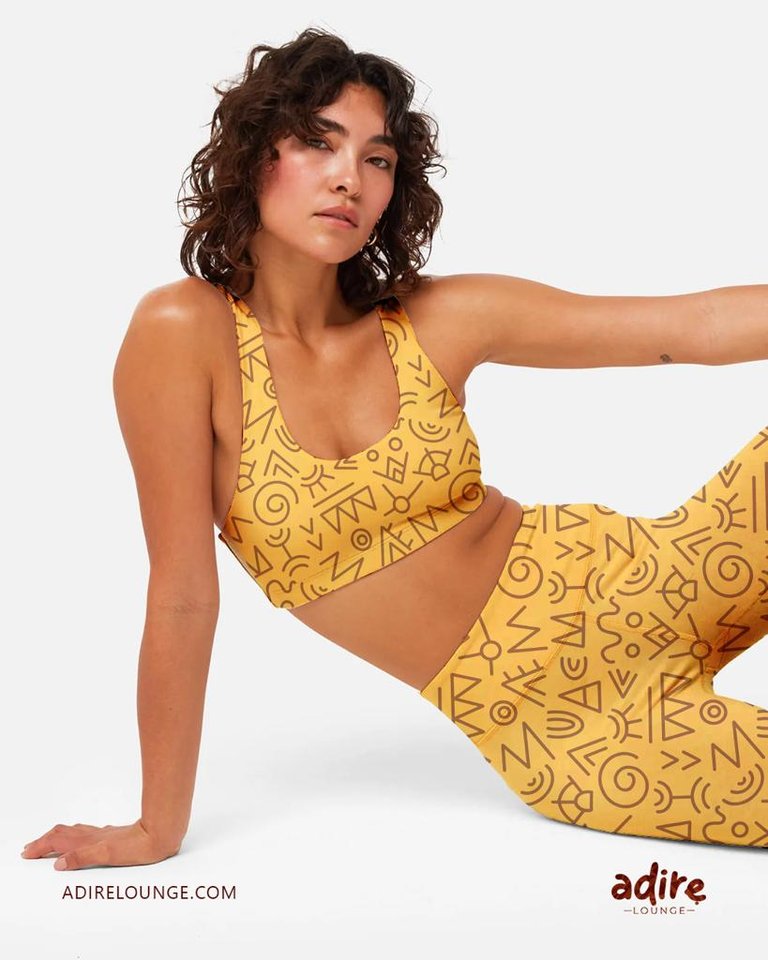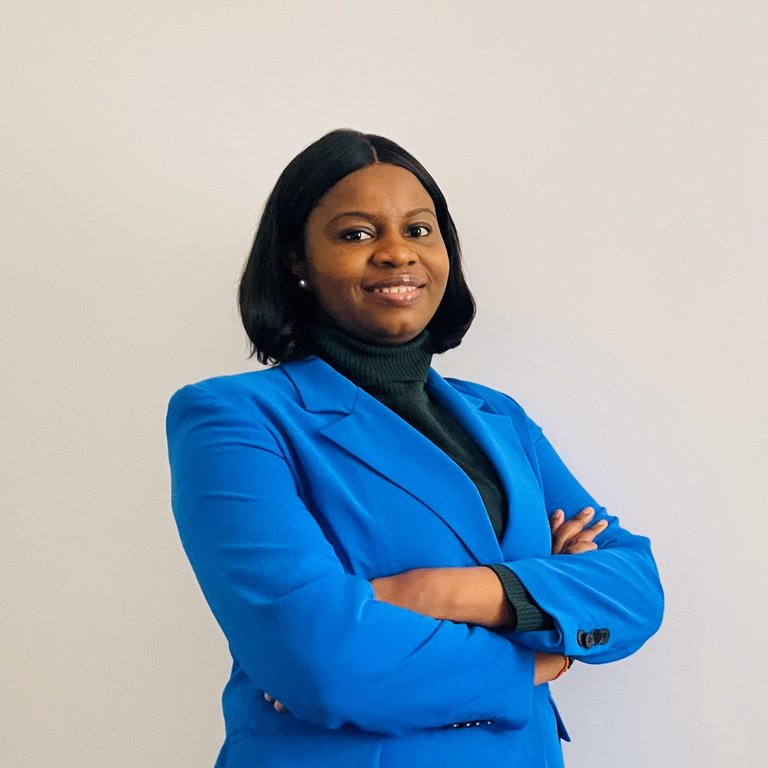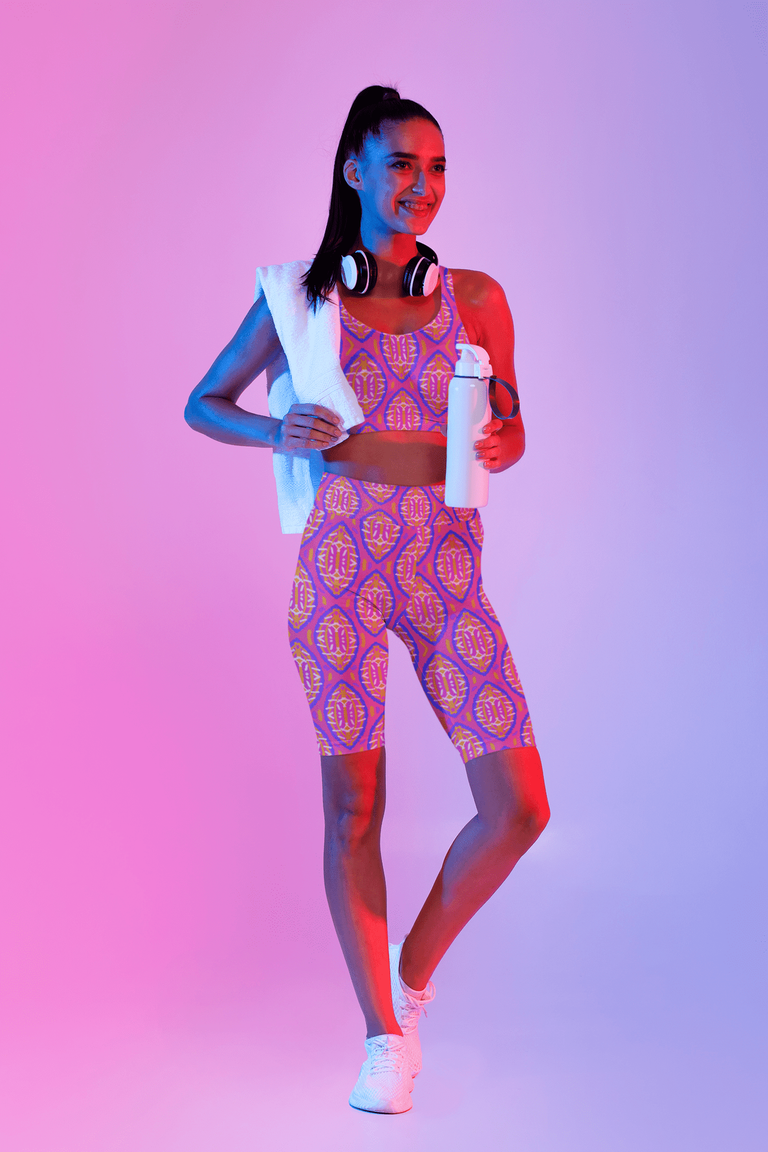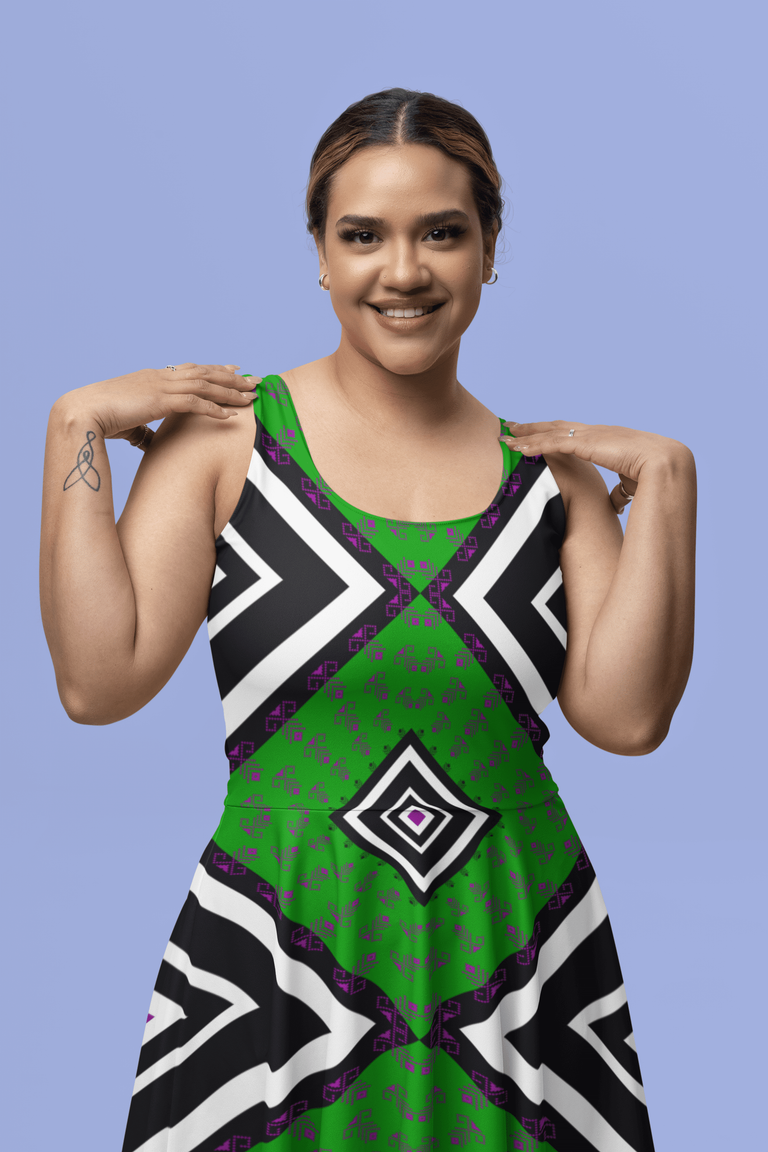Hey there, all you stylish pals out there! Have you ever wondered what happens when a fashion designer meets athleisure?
Picture provided by Cynthia Asije
www.shopadirelounge.com
Imagine if your clothes could be as comfy as pajamas but still super stylish. Wouldn't that be wonderful? 😄
That's what this amazing fashion designer does! She creates something called "athleisure." 😊
Ah, she is a creator, just like me, except sadly all my beadwork creations have the same names "Necklace", "Bracelet" or "Earrings" 😒
Ok then, what is this "athleisure"? You could say it's like athletic clothes and leisure (fun time) clothes had a big hug and became best friends! 👫
Aw, that is super sweet, don't you agree?
Now I definitely want that for my beadwork creations. The problem is I have so many, it would take me ages to find names for all of them. 😱
That would be a huge problem, because as some of you know I'm an autumn, or some evil minds may say winter chicken, so I am close to my expiration date. There is no way I could ever get it done. 😭
Nope, I don't want to talk about it so let's talk some more about this designer. She isn't just about making clothes look awesome. 😃
She's also a "textile designer." That's like being a superhero of patterns and colors for clothes and fabrics. 😉
So, in this blog post, we're going to dive into the magical world of this fashion designer and her athleisure creations. 🏃
Get ready to have fun, and discover how fashion and patterns can bring big smiles to everyone's faces! 😄
Picture provided by Cynthia Asije
What is your name, function and the company you work for?
My name is Cynthia Asije, I am the CEO and cofounder for Adirelounge.
www.shopadirelounge.com
How old are you?
I am 35 years old.
What kind of work do you do, or what are you studying to be?
I am a textile designer. I work with women in underserved communities to create patterns on clothing and textiles.
What made you decide to become a Fashion Designer?
Becoming a fashion designer and founding an athleisure brand was born from a deep passion for empowerment, creativity, and sustainability. Witnessing the potential within underserved communities, I knew that their unique perspectives could reshape the fashion landscape.
The decision was an amalgamation of my love for fashion, my commitment to creating positive change, and my desire to champion sustainability.
The empowerment of women in underserved communities isn't just a mission; it's the heartbeat of our brand. By allowing these talented women to create the patterns, we're not only fostering creativity but also providing them with a platform to showcase their skills to the world. This process honors their voices, stories, and traditions, infusing each piece with authenticity and cultural richness.
Sustainability, too, is non-negotiable in our journey. Knowing the impact the fashion industry can have on the environment, I wanted to offer a conscious alternative. Our commitment to sustainable materials, ethical practices, and mindful production processes reflects our dedication to leaving a positive footprint on the planet.
In essence, the decision to become a fashion designer and brand owner was driven by a vision of inclusivity, creativity, and sustainability. With every stitch, our goal is to celebrate individuality, inspire change, and weave a tapestry of empowerment that embraces both the wearers and the creators behind our athleisure pieces.
Picture provided by Cynthia Asije
Is fashion important to you? Why?
Fashion holds a significant place in my life for several reasons. Beyond being a mere form of self-expression, fashion is a powerful means of communication, creativity, and cultural representation.
Firstly, fashion allows me to express my individuality and personality. The way I dress can convey my mood, aspirations, and even my values. It's a way to make a statement without saying a word, and that ability to communicate through clothing is truly empowering.
Moreover, fashion is an art form that fosters creativity. From selecting fabrics and colors to designing intricate patterns, there's an immense joy in the creative process. It's an opportunity to turn imagination into tangible pieces that people can wear and experience.
Fashion also plays a role in reflecting and respecting cultural diversity. Clothing can be a celebration of heritage and a way to honor traditions. It's a visual representation of our collective history and identity, and it helps us connect with different cultures and perspectives.
On a broader level, fashion's impact on society and the environment is undeniable. The choices we make as consumers and creators influence trends, industry practices, and even conversations about sustainability. Fashion has the power to drive change in how we view and engage with our world.
In essence, fashion is important to me because it's not just about looking good; it's about feeling confident, expressing myself, celebrating diversity, and participating in a dynamic dialogue that spans creativity, culture, and consciousness.
What are your successes, and how did you achieve them?
I’m an award winning designer, empowered over 10,000 women in underserved communities in Africa, and exported our products to over 40 countries.
I was able to achieve this via years of hard work, figuring out how to scale a fashion brand globally, and partnerships with other
companies and organisations that have helped us scale our brand.
What’s something you might want to do in the future?
Something we will do in the future is leverage AI in our fashion brand. Also using the following ways to bring this to life.
Creative Collaboration:
AI would collaborate with human designers to generate new and innovative design ideas. It would analyze trends, customer preferences, and historical data to suggest design elements, color palettes, and styles that resonate with the target audience.
Pattern Generation:
AI would help create intricate and unique patterns that are challenging for humans to design manually. This would lead to more creative and visually stunning designs.
Sustainable Design:
AI would analyze materials, production methods, and environmental impact to suggest sustainable and eco-friendly design choices. This would contribute to reducing the fashion industry's environmental footprint.
Personalized Fashion:
AI would analyze individual preferences, body measurements, and lifestyle data to generate personalized clothing designs. This would revolutionize the concept of "made-to-measure" fashion.
Is the name of the Brand important to you when you buy clothing or jewelry?
The name of a brand is really not important, what’s important to me when buying clothing or jewelry is the fit, pattern, design, colors, and also quality of the products and how it fits my personal style.
Describe your personal style of fashion?
My personal style is a harmonious blend of conservative elegance and vibrant self-expression. I gravitate towards modest yet stylish clothing choices that reflect my values and respect my comfort zone.
Classic silhouettes and tailored fits are my go-to, allowing me to exude confidence
while maintaining a sense of sophistication.
My love for colors and patterns adds a delightful twist to my conservative aesthetic. I skillfully incorporate rich hues and intricate patterns into my outfits, showcasing my vibrant personality in a tasteful manner. From deep jewel tones to pastel shades, each color holds a special place in my wardrobe, allowing me to effortlessly transition from formal occasions to everyday life.
Patterns, whether subtle or bold, are an integral part of my style. I choose delicate florals, timeless polka dots, or intricate paisleys that enhance my outfits with a touch of uniqueness.
My mastery lies in the art of pairing patterns and colors, creating ensembles that captivate attention without compromising my conservative values.
Accessories play a pivotal role in my style story. Thoughtfully chosen scarves, elegant jewelry, and structured handbags complete my looks, adding an extra layer of refinement and visual interest.
In essence, my personal fashion style elegantly balances conservatism, color, and patterns. With each outfit, I confidently embody a sense of individuality and grace, making a statement that speaks volumes about my unique fashion philosophy.
How did you find your personal style? Do you have a signature look?
In finding my personal style and signature look I had to take these paths
Exploration:
I had to experiment with different styles, patterns, colors, and silhouettes to discover what resonated with me.
Research:
I studied various fashion trends, historical periods, and cultural influences to gain inspiration and insights.
Incorporate Passions:
I blended my personal interests and passions with my designs. This can be art, nature, music, or anything that sparks creativity.
As a fashion designer who loves patterns and colors, my personal style is characterized by vibrant and eclectic combinations.
My signature look involves incorporating intricate patterns, unconventional color pairings, and unique textures that set me apart.
Remember, finding your personal style and developing a signature look is a creative journey that evolves over time. It's about staying true to your artistic vision while adapting to the ever-changing fashion landscape.
Do you have an influence on other people’s fashion style?
Absolutely, my role as a designer creating batik and prints clothing/activewear has a profound influence on people's fashion styles. Through my unique designs, I have the power to shape and inspire the way individuals express themselves through clothing.
Here's an example to illustrate: Meet Prisca, a fashion enthusiast with a love for cultural expressions and vibrant colors. She comes across my collection of batik and prints clothing and is immediately captivated by the intricate patterns and rich hues. The designs resonate with her sense of individuality and her appreciation for traditional artistry.
Prisca decides to incorporate a piece from my collection into her wardrobe. She chooses a beautifully crafted batik dress that features a fusion of contemporary cuts with traditional motifs.
As she wears the dress, she not only feels a sense of connection to the cultural heritage represented in the design but also experiences a surge of confidence and self-expression.
Intrigued by the unique blend of modern and traditional elements in the dress, Prisca starts experimenting with other pieces from my collection. She begins to mix and match the batik and prints clothing with her existing wardrobe, creating dynamic and eye-catching ensembles that showcase her distinctive style.
Prisca's friends notice the transformation in her fashion choices and are inspired by her ability to seamlessly blend tradition with contemporary fashion.
They start exploring my collection as well, leading to a ripple effect of individuals embracing batik and printed clothing as a way to celebrate their roots while embracing modern aesthetics.
Through Prisca's journey and the influence she inadvertently exerts on her social circle, it becomes clear that my designs are not just garments, but vehicles for self-expression and cultural appreciation.
As a designer, I have the privilege of impacting people's fashion choices and helping them discover new dimensions of style that resonate deeply with their identities and aspirations.
Picture provided by Cynthia Asije
What are in your eyes the best trends at the moment?
Sustainability and Conscious Fashion:
The trend towards environmentally and socially responsible fashion continues to gain momentum, with a focus on sustainable materials, ethical practices, and transparent supply chains.
Athleisure and Comfort Wear:
The pandemic accelerated the demand for comfortable yet stylish clothing, leading to a rise in athleisure wear and loungewear that seamlessly blend comfort and fashion.
Bright Colors and Bold Prints:
Vibrant hues and eye-catching patterns have been making a comeback, bringing a sense of optimism and energy to wardrobes.
Nostalgia and Retro Revival:
Nostalgic fashion trends from the '90s and early 2000s, including baggy jeans, oversized blazers, and vintage logos, have been making a comeback.
Sculptural and Exaggerated Silhouettes:
Fashion designers have been experimenting with voluminous shapes, puffy sleeves, and architectural details to create statement-making silhouettes.
Gender-Fluid and Inclusive Fashion:
The industry is moving towards more gender-neutral designs, embracing diversity, and challenging traditional gender norms.
Digital Fashion and Virtual Experiences:
With the rise of virtual events and online interactions, digital fashion and virtual clothing that can be worn in virtual environments are gaining traction.
Craftsmanship and Artisanal Details:
There's a growing appreciation for handcrafted pieces, intricate embroidery, and artisanal techniques that celebrate craftsmanship and uniqueness.
Minimalism with a Twist:
A modern take on minimalism that incorporates unexpected details, textures, and layering, offering a fresh perspective on the classic aesthetic.
Global Influences and Cultural Fusion:
Designers are drawing inspiration from various cultures, resulting in collections that fuse traditional elements with contemporary designs.
What are in your eyes the worst trends at the moment?
The worst trends in fashion right now are these:
Fast Fashion:
The continuous cycle of rapid production and consumption that characterizes fast fashion has been criticized for its negative environmental and ethical impacts.
Overly Generic Designs:
Trends that result in generic, indistinguishable designs can lead to a lack of uniqueness and creativity in the fashion landscape.
Cultural Appropriation:
Trends that appropriate elements from other cultures without proper understanding or respect can be culturally insensitive and offensive.
Single-Use and Disposable Fashion:
Trends that promote single-use or disposable clothing contribute to waste and environmental degradation.
Lack of Diversity and Inclusion:
Brands that do not prioritize diversity and inclusion in their designs and marketing can face criticism for perpetuating exclusivity.
Excessive Logomania:
Overuse of branding and logos on clothing can sometimes be seen as excessive and lacking in subtlety.
Unsustainable Materials and Practices:
Trends that prioritize aesthetics over sustainability can contribute to negative environmental impacts.
Body-Shaming Styles:
Designs that promote unrealistic body ideals or subtly perpetuate body-shaming sentiments can be harmful to self-esteem.
Hasty Imitation of Subcultures:
When mainstream fashion quickly adopts elements from niche subcultures, it can dilute the authenticity and significance of those subcultures.
Uncomfortable Fashion:
Trends that prioritize aesthetics over comfort might lead to impractical and uncomfortable clothing choices.
What kind of fashion advice would you give us?
Certainly! Here are some fashion advice and tips that you might find helpful:
Discover Your Personal Style:
Take the time to explore different styles, patterns, and colors to identify what resonates with you. Your personal style is a reflection of your personality and can help you feel confident and authentic.
Invest in Staples:
Build a foundation of timeless and versatile pieces in your wardrobe, such as a well-fitting pair of jeans, a classic white shirt, and a versatile blazer. These staples can be mixed and matched with trendier items.
Quality Over Quantity:
Instead of filling your wardrobe with numerous cheap items, consider investing in high-quality pieces that will last longer and maintain their appearance.
Accessorize Strategically:
Accessories can transform an outfit. Choose accessories that complement your outfit and add a touch of personality, whether it's statement jewelry, a stylish belt, or a unique scarf.
Balance Trends:
While it's fun to experiment with trends, don't feel obligated to follow every passing fad. Select trends that resonate with your style and incorporate them thoughtfully.
Know Your Body Shape:
Understand your body shape and choose clothing that flatters your figure. This can help you highlight your strengths and feel more confident in your choices.
Who is your style icon, and why?
My iconic style icon is Audrey Hepburn. She is celebrated for her timeless elegance, sophisticated simplicity, and ability to make even the simplest outfits look effortlessly chic. Audrey's classic style, characterized by tailored silhouettes, little black dresses, and understated accessories, continues to inspire fashion enthusiasts around the world.
Is there something else you would like to share with us?
Yes we are launching our new batik activewear collection. This features a sports bra with long features, leggings with mesh and pockets. It's also in partnership with the women in underserved communities with a 50:50 revenue share.
This will enable them to grow their business, earn more income, afford education for their kids, and healthcare for their families.
Picture provided by Cynthia Asije
I appreciate your detailed responses to my inquiries, Cynthia. Your athleisure style is quite appealing if you ask me. 😍
If you're not ready to stop reading, you can hop over to the cool talks I had with some other fashion designers earlier! So, if you're up for more stories, they're just waiting for you to jump in and have a blast! 📚
https://seadbeady.blogspot.com/2023/07/interview-with-fashion-designer.html
https://seadbeady.blogspot.com/2023/05/interview-with-fashion-designer-igor.html
Hope you like my blog.....Until next time.....Have a nice day
Renata (Seadbeady)
Enjoyed this post? Never miss out on future posts and receive the next blog posts in your Email inbox
Follow me on Instagram
Join me in my Facebook group to get more involved, if you want to be in my next gift guide, or just keep in touch
Want to be on my blog next time?? Want me to review your product?? Just send me a message.
Liked my blog post? Share it with your friends by using the buttons below, or let me know what you think with a comment.

